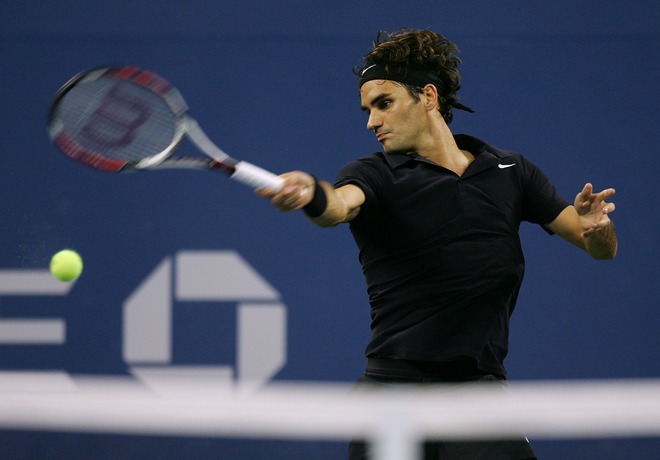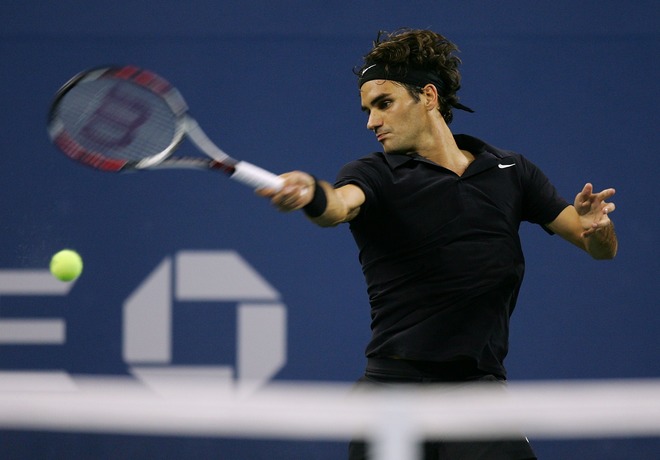
Darth SABR: Roger Federer joins the Dark Side

Any discussion about Roger Federer must be prologued by one undeniable fact: The rules are optional. If what we continue to see on our screens day after day is not reason enough, David Foster Wallace‘s legendary essay for the New York Times, 'Federer as a Religious Experience', can appease even the most die-hard tennis fan.
Following this pattern comes the cleverly-abbreviated Sneak Attack by Roger, or SABR. Despite the grumblings from his opponents’ boxes (looking at you, Boris), we cannot help but be dazzled every time he unsheathes his newest weapon.
From a technical standpoint, the SABR technique for return of serve can be broken down into three major parts: Advance swiftly into the court almost up to the service line when the server tosses the ball, return the serve on a half-volley and advance to the net while forcing your retreating opponent to make an error or hand you an easy finish at the net.
This sounds easy enough on paper, but the superlatives come into play when we watch Federer attempt this against some of the world’s best players at a Grand Slam.
In a sense, the SABR can be considered the cooler, rebranded version of the chip and charge. As with SABR, the chip and charge involves returning the serve deep to the server’s corners and charging the net in an effort to throw the server off. The differentiating factor is the higher level of aggression with the SABR as well as the calibre of servers that Federer currently faces.
“I did it in practice more as a joke, and I tried it again and again and again, and it just seems like it's not that hard for me to do,” he has said. But then nothing is that hard for him to do, or that’s the way he makes it look.
Having a reasonably strong volley game, I too have been a proponent of the chip and charge. And let me tell you, watching the average server’s reaction to a 6’1 tall player barrelling down the court at him as he finishes his serve motion is entertaining.
He looks for some way through, finds it but realizes he is out of time to line the winner up. He attempts a lob, but it rarely goes deep enough. As I attempting the SABR, I saw that the reaction time available drops exponentially. Either way, the point is over in less than 10 seconds, which is something that Federer will target more as he grows older.
At age 34, he has nothing to lose. To put it better, he has won everything there is to win. Thus, even attempting the SABR in a US Open final against Novak Djokovic, who is at the top of his game, does not sound entirely foolhardy.
The primary objective of the SABR is to disturb the status quo and change the direction of the game. Djokovic is well known as one of the game’s best returners, and this may have been Federer’s attempt to balance the scales to some extent.
However, success in tennis depends heavily on a player’s adaptability, which is why Djokovic was ready and able to respond to successive SABR attacks on his serve with a perfect offensive lob as seen in this video.
Now that the SABR has been studied and dissected, much of the element of surprise it depended on is lost, which is why I can see it being relegated to a less frequent, emergency-based use in the major matches ahead.
Amidst debate regarding the fairness of the technique and the possibility of disturbing the server with the early charge, it is pertinent to note that it is well within the rules to charge the net at any time after the server has tossed the ball. It is a high-risk, high-reward scenario and the closer the player is to the service line, the harder it is to get the half volley in. Moreover, Federer is one of the few remaining gentlemen in the game and thus, it is difficult to raise questions regarding sportsmanship.
In a subtle PR masterstroke, Federer has taken complete ownership of the SABR, which could just as easily have been called the Sneak Attack By Returner. Other players will try to mimic the move, but it will always belong to Federer.
This serves to maintain the image of a still-exclusive club of one in a day and age where more and more eager youngsters such as Nick Kyrgios and Dominic Thiem emerge from the woodwork to challenge the king for his throne. To them, I would say: Beware the King and his SABR, for Roger Federer is far from done.